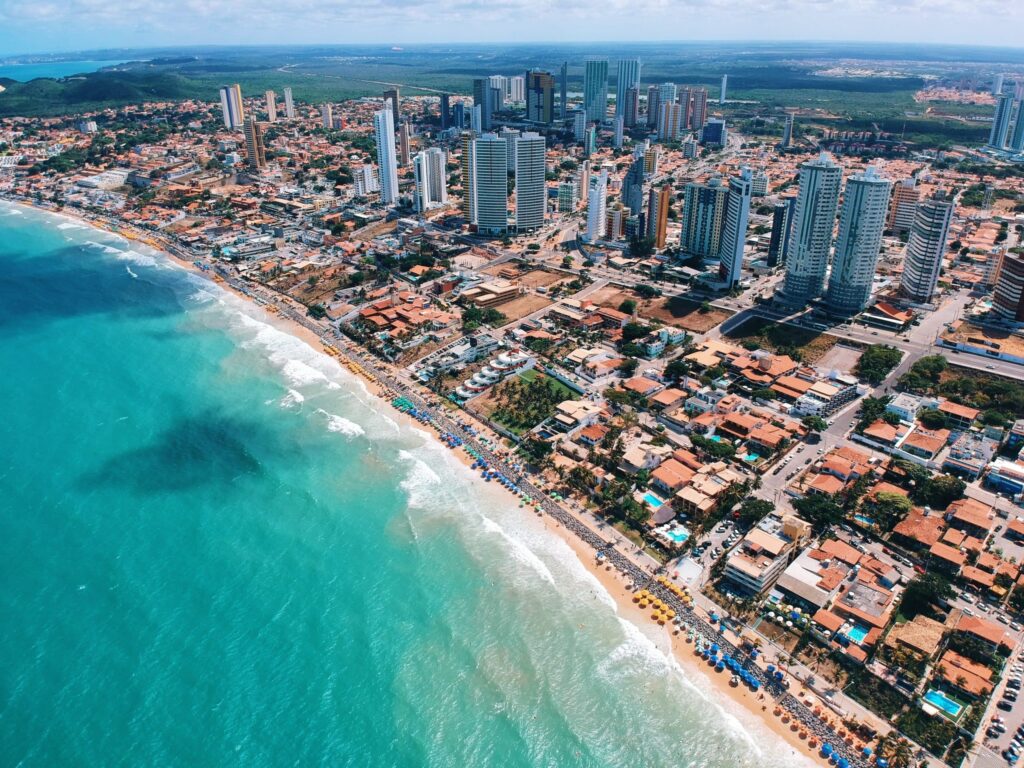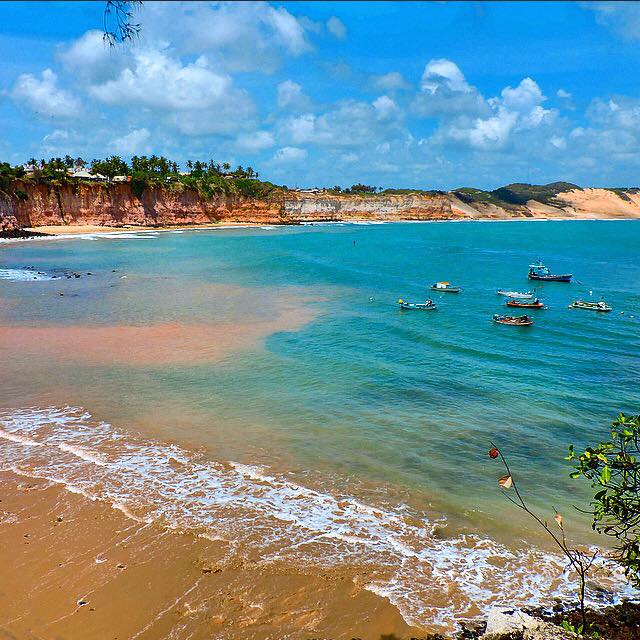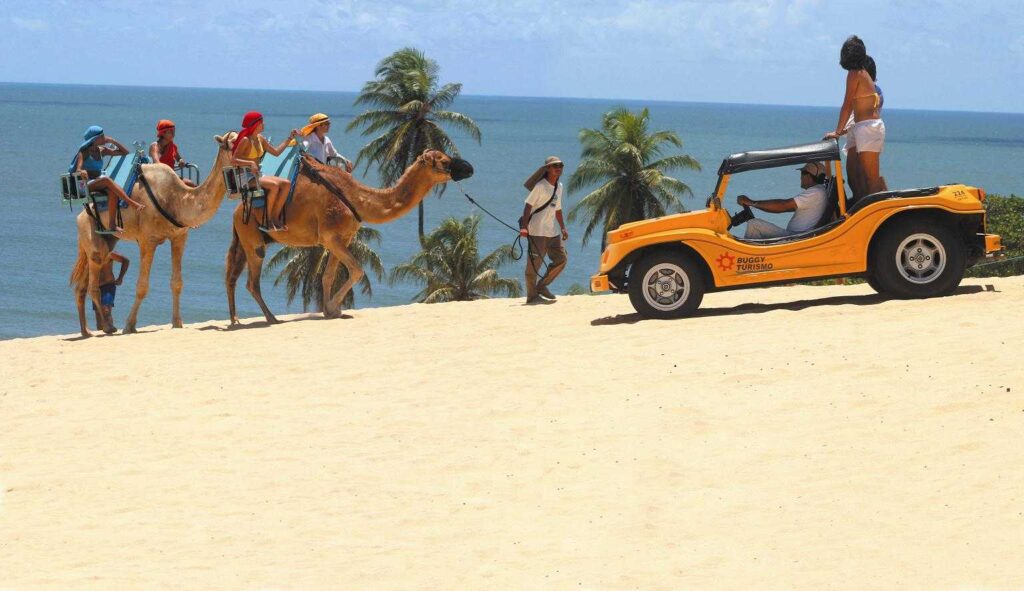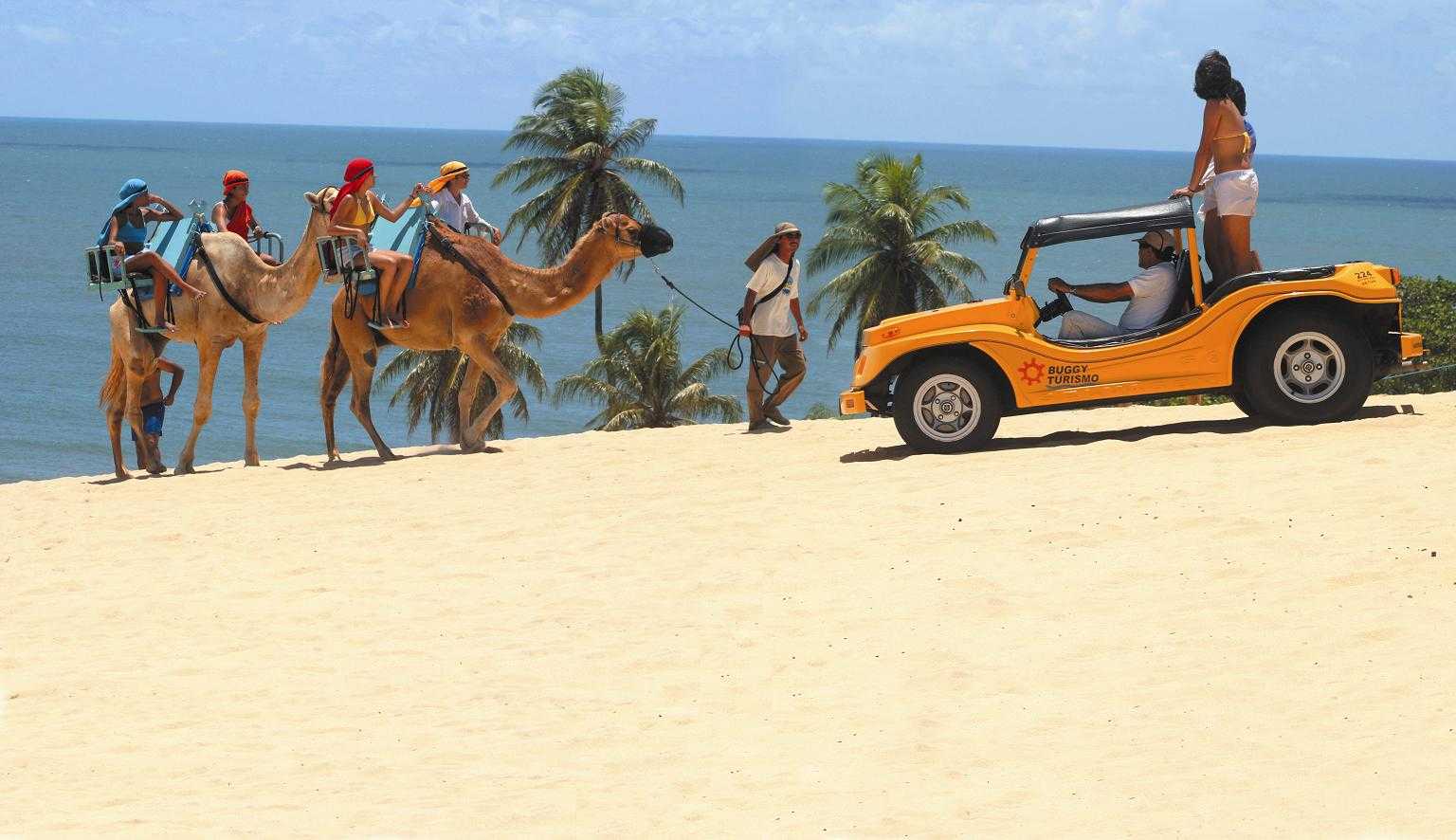Natal is known as the city of the sun, standing out for its beautiful lagoons, beaches, typical food and history. The city grew very slowly, developing from 1922 onwards, with its first neighborhoods being Ribeira and Cidade Alta.
The 400 kilometers of coastline in Natal and surroundings, framed by dunes, reefs, cliffs and natural pools, make the capital of Rio Grande do Norte one of the most popular destinations in the country. join it all buggy rides, rustic fishing villages, preserved nature, restless nights and sunshine almost every day of the year. Summary: perfect vacation!

Tours in Natal – Rio Grande do Norte
Formosa Bay
The municipality of Baía Formosa has the largest reserve of Atlantic Forest in the state, ideal for hiking, and beaches such as Sagi and Baía Formosa (homonymous), where swimming and fishing are great attractions.
Baía Formosa has several options for inns and hotels, as well as friendly chalets by the sea. You can choose between enjoying a good pizza, tasting typical foods or more sophisticated dishes. Baía Formosa has options for all tastes.
Be sure to visit the Bacopari Lighthouse, crochet handicrafts and places like Sagi Beach (via buggy), as well as the mangroves and Araraquara lagoon.
Sport and Ecotourism
The natural beauties of Natal are not restricted to contemplation. Its scenery and attractions are also used for sports.
Water sports are undoubtedly the most sought after, such as surfing and windsurfing on the urban beaches of Ponta Negra and Artistas; and diving in natural pools.
On dry land, buggy rides through the dunes are accompanied by exciting rallies aboard 4×4 vehicles, motorcycles and trucks. Trekking lovers will find trails in Parque das Dunas, set in an area of environmental preservation.
And the sky is not the limit in the Potiguar capital. Ultralight rides in Genipabu allow you to observe every corner of one of the most beautiful postcards of the Brazilian Northeast.
Reis Magos Fort
In the shape of a star, the fortress was built by Portuguese settlers in 1598, close to where the Atlantic Ocean meets the Potengi River. In 1633, despite the strategic location, it did not prevent the invasion of the Dutch.

Years later, the Portuguese managed to retake the city and the fort. The monument still preserves the cannons – exposed in the upper part of the building -, a chapel with a freshwater well and lodgings.
Mother Luzia Lighthouse (Natal Lighthouse)
From the top of its 37 meters high, accessible by a spiral staircase of 151 steps, the lighthouse reveals one of the most beautiful views of Areia Preta beach, allowing you to glimpse the beaches of Genipabu and Ponta Negra.

Built between 1949 and 1951 and administered by the Port Authority of Rio Grande do Norte, it runs on electricity, emitting flashes of light every 12 seconds over a length of 44 kilometers.
Coastal Way
On the left side of Via, is the Convention Center and 9 km of preserved dunes in the heart of the city. On the right side, hotels with bold architecture are concentrated on the seafront.
Beaches
Barra de Tabatinga beach
The cove of calm waters is sought after by families with children, who find the Tubarões Park there. But what guarantees Barra de Tabatinga's fame are the dolphins, who usually toast visitors in the late afternoon.

To spot them, head to the roadside lookout. While the animals do not appear, enjoy the view framed by dunes and cliffs. Tabatinga is the last beach on the south coast of Natal.
Genipabu beach
The great attraction are the dunes that, together with the buggies, make Genipabu a true amusement park in the middle of nowhere.
Rides can be “with or without emotion”, which means more speed and radical maneuvers through the moving and fixed dunes, occasionally blessed with freshwater lagoons. From the top of the sand hill, it is possible to appreciate the Lagoa de Genipabu and also take walks on the hump of dromedaries.

The route ends at Genipabu beach – although calm and protected by a column of reefs, it is not so beautiful due to the turbid waters. But take the opportunity to stop at Bar 21, certainly one of the most photographed in the world due to the perfection of the scenery: it is located at the foot of the dune, next to a coconut tree twisted by the wind.
Jacuma beach
The beach is the birthplace of “aerobunda”, practiced in the lagoon of the same name. The modality consists of going down a huge dune sitting in a chair attached to a rope, falling straight into the clean water lagoon.
Muriu beach
One of the beaches most sought after by holidaymakers in Natal, Muriú, stands out for its vast coconut grove and its waves. On its menu, shrimp and lobster for export.
North Pirangi beach
Like Ponta Negra, Pirangi has an excellent tourist infrastructure. Highlights include the beauty of its coconut groves, the Pirangi River and the boat ride on Cotovelo Bay.
Pirangi do Sul beach
The natural pools of Pirangi are the closest to Natal and the beach, from where schooners depart for diving. It is a stop option for those visiting the beaches of the South.
Ponta Negra beach
One of the best known postcards of the city, Ponta Negra is a whim of nature. Morro do Careca is its main natural attraction.
Redinha Beach
Starting point for tours along the North Coast, Redinha is also the meeting point of the sea with the Potengi River. The beach, which is home to a large fishing village, has strong waves and reefs.
Maracajau beach
Located 60 km from Natal, it stands out for the generosity of nature. The warm, crystal clear waters, home to countless species of colorful fish, are an invitation to take a dip in the coral reefs located 7 km from the beach.
To get there, speedboats are used and the site has diving material. There is infrastructure that has a restaurant and a water park.
Pipa Beach
This beach is south of Natal, close to Tibaú do Sul. On the way, in Pirangui do Norte, take the opportunity to visit the largest cashew tree in the world, which occupies practically a block.

There it is also possible to take a boat trip to visit the natural pools that form 1 km from the coast, with the right to dive.
Sport and Ecotourism
The natural beauties of Natal are not restricted to contemplation. Its scenery and attractions are also used for sports.
Water sports are undoubtedly the most sought after, such as surfing and windsurfing on the urban beaches of Ponta Negra and Artistas; and diving in natural pools. On dry land, buggy rides through the dunes are accompanied by exciting rallies aboard 4×4 vehicles, motorcycles and trucks.
Trekking lovers will find trails in Parque das Dunas, set in an area of environmental preservation.
And the sky is not the limit in the Potiguar capital. Ultralight rides in Genipabu allow you to observe every corner of one of the most beautiful postcards of the Brazilian Northeast.
How to go
There are flights departing from the main capitals of the country to Augusto Severo Airport, in Natal. For those traveling by car, there are two access routes that lead to Natal. Departing from the South, take the BR-101 and from the North, use the BR-304.
When to go
The best time to visit Natal is between November and February, when the city is full of attractions, with temperatures around 30º C.
Events range from film festival to Carnival. After that, it gets quieter and cheaper, but no less interesting, with thermometers registering an average of 27º C in the air and in the warm waters of the Atlantic. Rain only appears on a few days in June and July.
To stay
With its beautiful beaches and diverse tourist attractions, Natal attracts more and more tourists and more and more investments for the hotel sector, mainly in the charming inns of the place.
Natal's hotel network offers visitors the option of enjoying different locations in hotels and resorts, however, those located by the sea are more valued.
The 5-star hotels are located on Via Costeira, halfway between Ponta Negra and the city center, and those who stay in the area depend on a taxi or transfer provided by some establishments or by the hotels themselves.
Eat
When it comes to checking out the diverse cuisine of Natal, all roads lead to Ponta Negra, where most of the restaurants are concentrated. And although the dishes based on seafood – highlighting the moquecas and paellas served in Moqueca Capixaba and Samô – catch the eyes of any tourist, it is worth trying the typical delights of the local cuisine.
On the menu of establishments such as Camarões Potiguar, Paçoca de Pilão and Tábua de Carne, the stars are sun-dried meat, fried or cooked cassava, green beans, milk rice. It's worth saving room for dessert, which features cashew candy and top hat (banana with cheese).
Anyone who wants to try a little bit of each of the varied Northeastern recipes should head to Mangai. Flavors from all over the Northeast can be found in the rich buffet.
Weather in Natal – RN
Natal has an average temperature of 28°C, with days with up to 15 hours of sunshine. Summer is the best time to enjoy the beaches and the buzz of Natal and its surroundings. However, it is sunny and warm all year round in the region. Just avoid the rainy season, which runs from April to June.
Transport
The best way to get around Natal and discover the dozens of attractions in its surroundings is by car. It is easy to drive around the city, always having the waterfront as a reference. The Ponte de Todos – Newton Navarro – shortened the route between the beaches of Forte and Redinha.
Keep an eye out for crosswalks without traffic lights and don't want to drive on the Genipabu dunes. There, only accredited drivers (bugueiros) circulate, taking into account the risk of accidents.
Shopping
Natal has several spaces for selling handicrafts. Only in Ponta Negra there are two addresses – Vilarte and Mercado de Artesanato de Ponta Negra. But it is in Petrópolis that one of the most popular ones is located: the Tourism Center. Installed in the old public prison, the beautiful mansion gained charm by transforming the cells into stores.
It is there that the lively “Forró com Turista” takes place on Thursday nights. At each fair or market, it is impossible not to be surprised by the multitude of pieces made of clay, wood, fabric, glass, paint, as well as cashew nuts, cachaça and local spices. It is worth checking prices before buying, as there are similar products in different stores and stalls.
To acquire labyrinth lace works you need willingness. The region's lace makers' cooperative operates in the district of Campo de Santana, in the municipality of Nísia Floresta. It's a 45 kilometer journey, rewarded by beautiful tablecloths, rugs, cushion covers and napkins.
Tips
Spend at least one day at Pipa beach. The place is beautiful.
For those who want to enjoy Christmas night, the suggestion is Guinza Blue, a nightclub that works in conjunction with the Guinza restaurant. Both ended up being awarded by the jury of VEJA Natal – the first as the best place to go for two and the second as the best oriental in Natal. The nightclub is always open on Fridays, starting at 11 pm, and on other days it is reserved for events. Closed in the months of December and January, when it undergoes renovations to renew the decor.
The Sunset in Natal is one of the most beautiful in Brazil, and maybe even among the most beautiful in the world. It is worth spending some time enjoying the sunset on the Potengi River. A good place for this is Pedra do Rosário, in the upper part of the city.
Read too:
